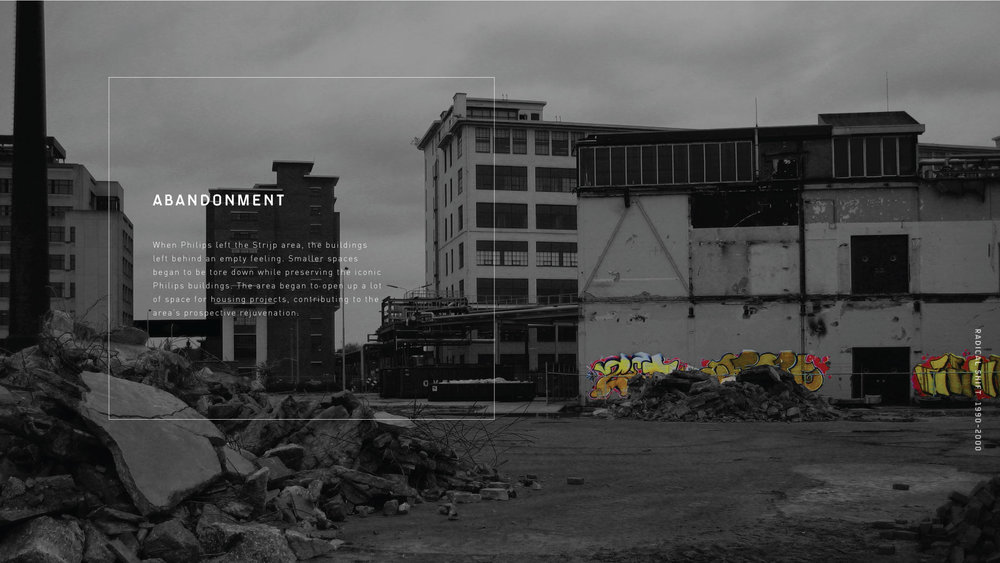
Urban Scale Study
Eindhoven, Netherlands
The purpose of this project is to study the transformation of the city of Eindhoven from its beginning roots with the start of the Philips lighting company in its industrial age, marking its transformation shift, and its current post-industrial state that is a vibrant, bustling hub for creativity. We also studied how the city evolved to make room for people to live in.
Jay Cheng, Delicia Li, Sara Milosavic, Victor Wong | 1 week Presentation

This project was recognized by our professor, Russell Taylor, as utilizing conventional technology to elevate our presentation by helping the audience better understand the movement within the city and he acknowledged the art direction of the presentation.
You can view our final presentation here.
Project Impact + Role
This project was a one-week research study and visual design project where our team studied a European design city in-depth. My role in the project was mainly helping with visual design, copywriting, synthesizing the research into a proposal and managing the overall strategy for the presentation. I also ensured that the team was on track for the on-screen presentation for the week after.
Process
We first evaluated Eindhoven by first better understanding how specifically the Strijp-S region started by immersing ourselves into the city’s history and context by mapping it out onto a textual timeline. We really tried to understand the circumstances that affected the city’s transformation and how all these individual pieces fit together into a whole. By marking the city’s shift through three time paradigm segments: industrial, modern shift, and post-industrial, we were able to visually communicate the city’s rich history.
Industrial Period
The industrial period was notoriously known for Philips’ factories that helped the city’s economy flourish and these successful factories maximized their use of space in order to improve productivity.
Modern Shift
The region began to change when the Philips factories left the area which left these iconic buildings to be repurposed and were remnants of its past history. Small pieces of creativity began to seep in from the abandoned buildings and was a turning point for the city’s transforming development.
Post-Industrial Period
In its current day, Eindhoven is bustling with a creative and knowledge economy that continues to sustain this vibrant cycle. By hosting its Dutch Design Week, ensuring schools that support a mixture of design disciplines that continue to challenge the norm, and possessing unique repurposed buildings, the city began to glow with the inner light of its past.
Use of Scale
With the constraints of an on-screen presentation, we thought about utilizing Google Maps and its existing animation technology to better transition the audience through the complexities of the Strijp-S region of Eindhoven. This would allow us to break down the context of the city through the overall Netherlands country structure, the city itself, and navigate by zooming in and out to carefully bring out and respect the context intricacies of the area.
Art Direction
When we were thinking about the art direction for the presentation, we wanted to strategically use the Strijp-S’ founding history of the Philips lighting company as inspiration for our theme of “Leading Lights”. The art direction focuses on the use of light as driving focal points for the audience in order to point out important key visual cues. Further, we wanted to fully embrace Eindhoven’s growth as a city that is shaped by small glimmers of lights that have reignited and restored the city’s vibrant life in a different form.
Leading Lights
The presentation will focus on highlighting the growth of the city of Eindhoven from its roots into an area full of youthfulness and vibrancy. Neon tones against the dark tones were chosen to represent the clash between the past and the future. The dark background helps bring out the neon colours which becomes the focal point of each moment in time. The Eindhoven type was used to pay homage to the design city’s quirky edge and DINPro-Regular was used for the body text to ensure legibility.
Reflection
As a team, we wanted to communicate the intricacies of the Strijp-S area by carefully crafting the presentation with the unique circumstances faced by the city in mind. We believe we have been able to tell a story behind the city’s evolution and how light has been a distinguishing factor for the area to bring out its current driving force through their creatives as well as knowledge-seeking institutions.








